A Bean, By Any Other Name, Wouldst Taste As Sweet?
Beans are in my blood.
I grew up eating them, child of Appalachia that I am.
A cheap source of protein, dried beans were not only an easy meal, but they were a way of life, especially in the wintertime.
When the weather was cold and blustery, the remedy was to put on a pot of beans.
And a “pot of beans” meant beans seasoned with some sort of pork, whether it was a hamhock, fatback, jowl bacon or even just a dab of bacon grease. An onion, a bay leaf and maybe some garlic might go in the pot, but they were all optional.
The necessary item for a good pot of beans was some sort of pork product, preferably smoke cured. That is what added depth and a sweet smokiness to the beans, and made the broth, known in some families as “pot likker,” a heavenly brew. I was notorious for craving the bean juice as much as the beans themselves, and would drink it like soup from a mug if I was allowed.
But it wasn’t just dried beans I grew up with. Oh, no–my grandparents grew several different kinds of beans on their farm, too. Most noteably bush and pole green beans, and lima beans.
The bush beans we ate young, as green beans, and we’d can them young, too. Sometimes, Grandma would pickle some, too.
The pole beans, we’d eat young, but Grandma would wait until they matured farther, and we’d make “shelly beans” with them, and then she’d can them that way.
“Shelly beans” are green beans that are old enough that the pods are tougher, and you string them, open them up and scrape out the beans. You still eat the pods–they still go in the pot, but with the beans removed, they don’t take as long to cook and get tender. And if any of the beans in the batch are younger, you just string and snap those like normal so what goes in the pot is a mixture of snapped beans, open and emptied bean pods and shelled beans. This was all cooked up with onions, pork and sometimes potatoes, and was very good, though I tended to like the tenderer young pods best.
Lima beans–those were eaten green. We didn’t leave them on the vine to ripen and dry to make dried beans. Grandpa planted both baby limas–those tiny-podded wonders that had beans in them that were barely larger than a kernel of field corn (corn that is meant to feed livestock), and sweeter than candy, and regular large limas, that were starchier and plumped up when you cooked them until they burst out of their skins.
Lima beans tasted good, and Grandma used to can them until she switched over to freezing them. But whether they are canned or frozen, processing them meant we had to spend long, long hours shelling them out of their pods, and there is nothing tougher than a lima bean pod. I hated the work, because shelling lima beans took strong hands, and it would make your thumbs ache. And it took lots of us to shell them out to freeze, too–six sets of hands at the least. When we had enough folks, when I was younger, I used to get the job of picking the beans from the vines and putting them in the baskets of the cousins, aunts, uncles and other relatives, who sat in comfortable lawn chairs and rockers under the locust tree next to the barn, where they could shell beans in the comfort of the shadiest, breeziest spot on the farm. But when there were fewer of us, and after I got older, I always had to shell them, and I would go home with thumbs aching from having to string pods that were so tough they seemed to be made of kevlar, or at least chiten.
But, much as I disliked the thumb-wracking work of shelling limas, I still miss gathering in the shade, in rocking chairs, and listening to the folks gossip and tell stories on each other, tales punctuated by the metallic ping of beans striking the metal colanders we all held in our laps to recieve the shelled beans. The pods went with the uprooted vines, onto a tarp in the middle of our circle. After we were done, the vines and pods would be divided up among the pigs, chickens and cows, all of whom loved the flavor of the greens, and who relished cleaning up what we could not ourselves eat.
I felt all of that coming back to me today as I shelled these beans I picked up at the farmer’s market on Saturday.
I saw them, practically being ignored in a stall filled mostly with more conventional green beans and onions, a stall run by an older lady who reminds me of my Grandma’s best friend, Becky, a lady, who like Grandma, has long gone to that great garden patch in the sky. No one else seemed to be paying any attention to these unusual looking knobby-podded beans, but they caught and held my eye.
Because they looked like a bean I had read about in Marcella Hazan’s and Paula Wolfert’s books: Italian cranberry beans.
They were long and knobby, with plump pods, some of which were pale green, but most of them were ivory to creamy-buff in color. All of them were streaked with brushstrokes of cerise; they looked as if a pixie with a paintbrush had been at them.
I couldn’t resist. I stepped up to the nice lady and asked her what those beans were.
She smiled brightly–obviously she liked these beans.
“Those is horticultural beans,” she said, nodding. “Not many grows ’em.”
“They are for shelling, aren’t they?”
She beamed, and nodded. “Uh, huh. Cook em with pork–I know you’ll love ’em if you try ’em.”
I nodded and smiled. “I’ll take a box of them.” (Which looked to be about two quarts of pods, which I figured would give me about a pound of beans. My estimation was correct.; once shelled, they made about a pound of beans.)
She grinned with delight and dumped the box into a bag and we exchanged cash and she smiled. “Let me know what you think of em when you come back next week.”
As we stepped away, Zak said, “What kind of beans are those?”
“Cranberry beans–in Italy, they are known as cranberry beans and they are eaten in Tuscany, in particular. Marcella Hazan says that they are best fresh like this, and bemoans the fact that you can mostly only get them dried in the US, if you can even find them at all. They are supposed to be creamy and sweet.”
“So, what you are saying is you found a treasure, huh?”
“Yep.”
So, the beans, whether you want to call them horticultural, French horticultural or cranberry beans, came home with us.
And I got the pleasure of sitting my sunporch and shelling them. Though, it isn’t the same without the gossip and my Grandma’s laughter, I did have the rocking chair, a cat (Grimalkin) tumbling at my feet, and I could sit and watch the fawns and their mother cavort in our backyard, as well as the birds go about their business. It was almost as good as sitting under the locust tree beside the barn and looking down the slope over the field at the pond and the woods below. It was better, actually, in one way, as it was inside and thus the mosquitos couldn’t get me.
And, these many-named beans didn’t make my thumbs hurt.
How did I cook them?
Well, in an improvised fusion between Appalachian Hillbilly cookin’ and Tuscan Country Folk cuisine: I made a pasta fagiole dish that included locally raised and cured ham from Harmony Hollow Farms, a caramelized sweet onion from the lady who grew the beans, garlic from yet another farmer, and herbs, chiles and minature plum tomatoes from my own garden. Everything in the dish was local except the Parmesan cheese, the pasta, the wine and the chicken broth.
It turned out very, very well, too. The beans were delicious, just as creamy and nutty-flavored as Hazan and Wolfert promised. The only improvement I could make in the dish would be to add a rind from a piece of Parmesan to the bean pot, and to use a smaller shape and size of pasta–I think that small shells would be great, because they could cup and hold the beans perfectly.
I believe that we will be visiting that nice lady again on Saturday and picking up another bag of these delicious whateveryouwanttocallem beans, for they were awfully tasty.
Besides, that gives me an excuse to sit in a rocker on my sunporch and spend a nice hour shelling beans, and watching the deer.
Appalachian-Tuscan Fusion Pasta Fagiole
Ingredients:
3 tablespoons olive oil
1 tablespoon bacon grease (optional)
1 large onion, thinly sliced
1 teaspoon salt
2 ounces boneless ham, cut into small dice
1-2 fresh chiles–to taste–minced
black pepper to taste (I used Aleppo pepper flakes instead–about a teaspoon of them)
3 large cloves garlic, minced
2 tablespoons minced fresh sage
1 tablespoon minced fresh rosemary
1/2 cup dry white wine, sherry or marsala
1 quart chicken or vegetable broth
1 pound shelled fresh horticultural/French horticultural/cranberry beans
1/2 pound fresh plum tomatoes, chopped
1/4 cup minced fresh basil
1 pound pasta of your choice, cooked al dente
freshly shredded Parmesan cheese, for serving
Method:
In a heavy-bottomed pot or Dutch oven, bring olive oil and bacon grease, if you are using it to heat on medium. When bacon fat is melted, add onion and sprinkle with salt. Cook, stirring, until onion is dark golden colored and smells sweet. Add ham, chiles, pepper, garlic sage, and rosemary, and continue cooking, stirring, until the ham browns slightly, the garlic is golden and the onions are brown.
Add wine, and stir to deglaze pan, and allow alcohol to cook off.
Add whichever broth you are using, and the beans. Allow beans to come to a simmer, turn heat down, and partially cover pot. Cook until beans are just softened, and the skins are starting to crack–about an hour. Remove lid, turn heat up to high and carefully allow broth to cook down until it is barely covering beans. Add tomatoes.
Using an immersion blender, puree about 1/4 of the beans, to make a thick gravy. Allow tomatoes to soften and begin to break down. Stir in half the basil.
Dump drained pasta into bean pot and toss to combine.
Put into heated bowls to serve, and top with a sprinkling of cheese and some more basil.
28 Comments
RSS feed for comments on this post.
Sorry, the comment form is closed at this time.
Powered by WordPress. Graphics by Zak Kramer.
Design update by Daniel Trout.
Entries and comments feeds.

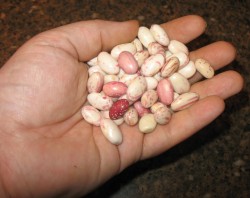
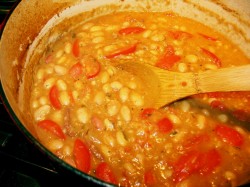
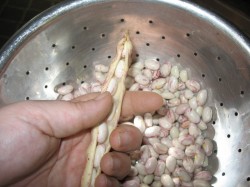

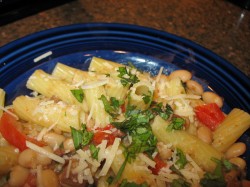
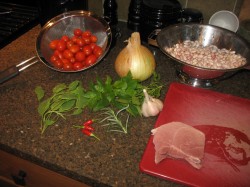


Somehow I always get the feeling that the grass is always greener at someone else’s farmers market. I hardly ever see really unusual things at my market here, but once in while they pop up. Like purple finger potatoes – one booth started selling them last year, now several people are. Tell your bean lady to come up here and teach these folks how to grow those beans!
Comment by Rosie — August 8, 2006 #
Tuscan Hillbilly, the new fusion. Lovely storytellin’ …
Comment by Alanna — August 8, 2006 #
Minus the pork products, that’s actually very much like the pasta fagiole I grew up with. And it looks like you used… rigatonis? My family’s Italian, and when we made pasta fagiole it was always a pasta with beans, not a soup or stew. (Also? Had no idea how to spell pasta fagiole – pronounced pasta va-zhool – until I was well into high school.)
Comment by Bomboniera — August 8, 2006 #
Often when I read your posts, I find myself hoping I’ll find whatever it is you’ve found at your farmers market at mine–and sometimes I do. Now hoping to find some of these or their like.
I just made some beans myself, but their origin was known only so far as the back of my shelf, where they’d been for some time.
Comment by lucette — August 8, 2006 #
Rosie–when we lived close to Columbus, I noticed that the farmers there were more conservative in what they grew. Here in Athens, there is an international population who shops at the farmers market , as well as Appalachian natives mixed with a bunch of world-traveller hippies and university professors. Thus, we get all sorts of stuff here that is just amazing. Bitter melon (which alas, I cannot have until this baby is born–it causes uterine contractions), Thai eggplants, tatsoi, mizuna, choy sum, pea shoots, garlic scapes, snake gourd, Malabar spinach, okra, ramps, horticultural beans, kabocha pumpkin–the list goes on and on.
Athens is well worth a visit, if nothing else to see the market–even folks from some bigger cities are impressed with what we have going on here when it comes to food.
Alanna–thanks. Those beans got me to thinkin’ while I was shelling them in the quiet of the sunporch. Made me remember all those summer days shelling beans long ago.
Bomboniera–I have actually seen fagiole spelled phonetically in cookbooks–fazoole! Although, I learned to pronounce it vazool, too, from Aunt Nancy, who grew up in Providence, RI, in an ethnically Italian/Portuguese neighborhood.
I have had it as a soup or stew, but I like it better as a pasta with bean sauce. And yeah, the little rigatoni was the last pasta in my pantry–not perfect for the sauce–the shape was wrong, but other than that, Zak and Morganna loved the dish, so I reckon I will be making it again. (The ham and bacon grease was my nod to my Appalachian roots. I think it would be nearly as good vegetarian, really.)
Lucette–well, you have three names to ask for them under, now! I am trying to remember if there is a significant population of Italians in Cleveland–if so–you may find someone who grows these up there!
Comment by Barbara — August 8, 2006 #
Although, I learned to pronounce it vazool, too, from Aunt Nancy, who grew up in Providence, RI, in an ethnically Italian/Portuguese neighborhood.
The Frugal Gourmet made the soup/stew version one day, and pronounced it… well, correctly, I imagine. “Pasta e fagioli.” And it took me almost ten minutes to figure out what he was talking about! “Oh! Pasta va-zhool!”
I’ve made it veggie, and it’s definitely good that way. Nana used chicken stock, and almost always rigatonis or ziti – she always had them on hand.
I don’t know if it’s just because I live in DC now, or because penne’s gotten so freakin’ popular that rigis and ziti have fallen out of favor, but I have a heck of a time finding them anymore. I grew up eating them all the time. And pastina? (Acini de pepe – I know pastina can refer to any small pasta, but we said pastina we only meant acini de pepe.) Forget it. I have to buy boxes when I’m home.
Comment by Bomboniera — August 8, 2006 #
I miss having brown beans and cornbread in the winter. I can make them, but not like my mother did, or even like the elementary school cafeteria ladies did. I used to love bean broth too, with tabasco sauce.
You’ve inspired me. I’m off to the farmer’s market as soon as I get home from vacation.
Comment by Honey — August 8, 2006 #
What a wonderful story…
I sometimes see these at my local supermarket, but have never bought them. Now I know what to do with them! I’ll keep my eyes peeled…
Comment by Diane — August 8, 2006 #
I’m not from Appalachia, but I can remember many a night when a nice pot of beans was served. Now I particularly enjoy five bean soup and making it from scratch. It is so hearty and warm and filling, it is the perfect recipe for a winter’s night!
Comment by risingsunofnihon — August 9, 2006 #
Cranberry Beans! I haven’t seen them in decades. Thanks for bringing back lots of memories of shelling beans, baking beans and eating beans. The whole family used to shell, sitting around the kitchen wood stove or out in the shade by the garden. We put up a hundred pounds a year, sometimes more.
My sister probably has less fond memories as she jammed a piece of dried pod under her fingernail when she was little.
When I grew up in New Hampshire, we just called them Mrs. Whitaker’s beans – after the lady across the street who had grown them for ninety years. (She passed away when she was 105.) We were the only two families we knew who grew them. Sadly, we lost all the seed crop after my grandfather died and never grew them again.
I never even knew to call them cranberry beans. Thanks!
Comment by Dan Jenkins — August 9, 2006 #
Rigatoni and ziti I could get pretty consistently in Columbia, MD, when we lived there, Bomboniera. You might try there….
Honey–try a ham hock. That is what makes brown beans for beans and cornbread delectable.
😉 I grew up on that.
Diane–they are great. Can’t wait to pick some more up and cook them again!
Risingsun–beans are some of my favorite food….especially now that meat is not really suiting my palate at all.
Dan–great to hear from you again! They are an heirloom bean–and you can get them under various names from various seed companies.
It is nice to hear stories about foods that were unique to you and your neighbors–and sad that the variety was lost to you for a while. That is what happens when folks die and don’t pass the seeds they have grown and saved for generations down.
Hence all the “seed saving” organizations out there doing great work preserving these old treasures!
Comment by Barbara — August 9, 2006 #
This post inspired me to buy a big bag of these beauties at the farmer’s market today! Thanks Barbara…
Comment by Raedia — August 11, 2006 #
I was so happy to read your post on the Horticulture beans. My husband is the gardner and I am the cook. He has planted these beans for years and I never knew what they were used for. He aquired the seed from his grandfather who, if were alive today, would be a 100. We have always used them as you would a pinto bean for soup but tomorrow it is Pasta e fagiole.
Comment by Crystal — August 11, 2006 #
Raedia–let me know how you like them!
Crystal–glad to oblige! I suspect that there are plenty of other uses for horticultural beans–Dan says his family up north used them for baking beans. I bet they would be good that way, too.
I am hoping to get another batch of them tomorrow. I want to make pasta fagiole again, but I also want to try them a different way, too. Maybe I will buy two boxes this time around!
Comment by Barbara — August 11, 2006 #
Crystal-They made an excellent pot of baked beans. As well as great bean soup. We were not culinarily adventurous when I was young, so I never had a chance to try them in a range of dishes before we lost our seed stock. Now that I know their name, I’ll be on the lookout for them.
Comment by Dan Jenkins — September 5, 2006 #
[…] I wish I had made note of who was selling them. I just recall that it was a woman. I noticed the pods and recalled a recent entry on Tigers & Strawberries about horticultural beans (another name for cranberry beans) and recognized them instantly. This is definitely one of the benefits of reading food blogs. I probably wouldn’t have looked twice at the beans had I not previously read about them and I would have missed out on something tasty. […]
Pingback by Regional Market Cranberry Beans at Couteau Bonswan — September 16, 2006 #
all these messages are so great! last fall i went to italy; would return in a heartbeat! for xmas my husband bought me 4 italian cookbooks, one titled Fagioli and the recipes are great. i live on an island in alaska with a short growing season; it’s not warm enough to grow beans. in the bean book, it suggests substituting ‘great northern beans’ for the cranberry ones. it works. i’ve never seen cranberry beans sold anywhere but now i will keep my eyes peeled. thanks for your recipe too. keep on shuckin and cookin.
Comment by sarah — March 9, 2007 #
Thank you, Sarah.
Comment by Barbara — March 14, 2007 #
Thank you for the very nice article. I have not had these beans in years. Here in Western KY we call them Horticulture beans. The pasta recipe looks very good. I’ll have to ask my new daughter-in-law of Italian descent and whose family is from RI if she has ever had it.
Comment by Kathy — September 27, 2007 #
Barbara,
My bachelor uncle lives in a cabin and learned to garden from his Arkansas-born father. This weekend he gifted our family of 5 with 2 bushel of horticulture beans. As we sat in the shade and shelled the beans, we enjoyed each other’s company. Shelling the beans was already having a magic work, but I wondered how I’d preserve them and exactly how I’d fix them. I remembered eating a pale, sweet and creamy mixture as a child and wondered how to replicate that for my family. I googled “horticulture beans” and found your wonderful food blog! Thanks so much for the education, the clarification and the delicious recipe. Now I know what we’ll eat for supper; I have all the ingredients but the ham on hand. One question about preserving–do you recommend blanching the beans before freezing?
Comment by Sheri — July 28, 2008 #
OH, I wanted to add: The horticulture bean seed was my grandfather’s, and it had been in the refrigerator for 20 years when my uncle planted them this spring! He had a marvel harvest.
While our family sat and shelled the beans, a fawn and her mother walked along our creek and into the woods.
Comment by Sheri — July 28, 2008 #
Thanks for the story and recipe. I have a great crop of horticulture beans in my garden this year (my parents always called them fresh pintos) and I googled the see how other people cooked them. I certainly intend to try a similar version of your recipe. In Arkansas we cooked them much like you did in Appalachia. They are usually available at our farmer’s market in
Fayetteville, Arkansas along with many other heirloom and ethnic vegetables.
Comment by Linda — July 14, 2009 #
We live in Missouri and what would a garden be without horticulture beans? Granny always referred to them as “bird egg” beans and we still call them that today. Just finished two days of “beaning” and have 88 pints of those little rascals in my freezer..but..oh my aching thumbs!!! Nothing better in the winter then bird egg beans and cornbread..pintos can’t hold a candle to these brown beans! My brother, his wife, my 86 yr old mother, my husband and me..shelling beans, laughing and remembering good times! Heaven!!
Comment by Nancy — August 4, 2009 #
I just made your recipe last night and it was delicious. My mom is from East Tennessee and my dad was from Arkansas, so I grew up eating shelly beans (if we were lucky, from my grandparents’ farm outside of Knoxville near the mountains). Anyway, I found cranberry beans at a local farm stand near where I live outside of Albany, New York, and bought them because they were so interesting-looking…had no idea what they were nor what I was going to do with them. My husband (who is a fine cook) actually recognized them as cranberry beans, so I googled around for recipes and found yours. Since I’m a grandchild of the South, I keep bacon grease for making cornbread, and between our herb garden and local farm stand, amassed all of the herbs and vegetables needed. Oh, and I threw in a parmesan rind while the beans were cooking; used penne because we had some really good whole wheat on hand. My husband and I had a lovely candlelit dinner and I’ll be making this again. I think I’ll go back to the farm stand and buy some more beans and freeze them, and we’ll be bringing our herb pots in for the winter…thank you so much!
Comment by Jane — September 9, 2010 #
[…] said the other night that soup sounded good for dinner the next day, and I had fresh horticultural beans in my refrigerator from the farmer’s market, and some ham (but no ham bone) in the freezer, […]
Pingback by Tigers & Strawberries » Beans, Beans, The Magical Fruit! — August 12, 2011 #
I grew up with cranberry beans. Thanks for bringing back that memory. I think my granny or grandpop got them originally from our 100 year old neighbor, Mrs. Whitaker. We grew as many as 200 pounds of them every year. They made great baked beans. We just knew them as Mrs. Whitaker’s beans, until I learned cranberry beans. Never heard that they were Italian or horticultural beans til here. Thanks for reminding me.
Comment by Dan Jenkins — August 14, 2011 #
Hello!! I bought these strange white and red pearl beans at my local farmers market yesterday. They were just so pretty! The lady at the stand said they were like a kidney or a black eyed, but I wasn’t sure what to do with them – cook them, or store them, or how! Thanks for your page and great recipe, which I plan to try out today!
Comment by Carrie — August 23, 2011 #
I really enjoyed reading this. for the past 6 years I have been getting my hands dirty with some gardening. usually the basic things like tomatoes, onions, peppers etc. The past couple years I have been trying to add a few new things to my list. this year is yellow squash, popcorn and horticulture beans. My daddy went and bought a bunch of the seed beans in a little paper bag. he planted what he wanted and gave me the rest. I am excited to see how they will grow. This is going to for sure be a first for me. I fix soup beans for my family at least once a week in the winter months and I am hoping that this saves me some money. I even have a few great ideas on how to fix the beans since I have read this. I can almost taste the beans now. Thanks!
Comment by Laura P — June 12, 2012 #